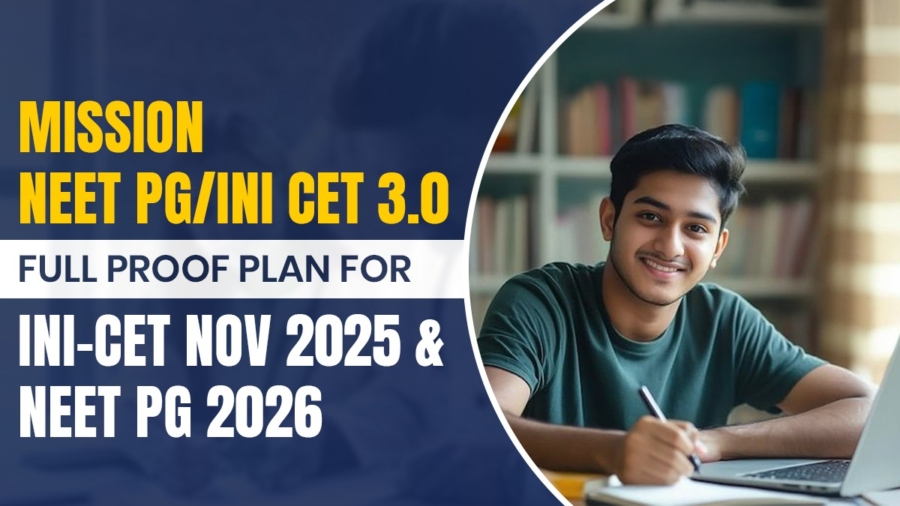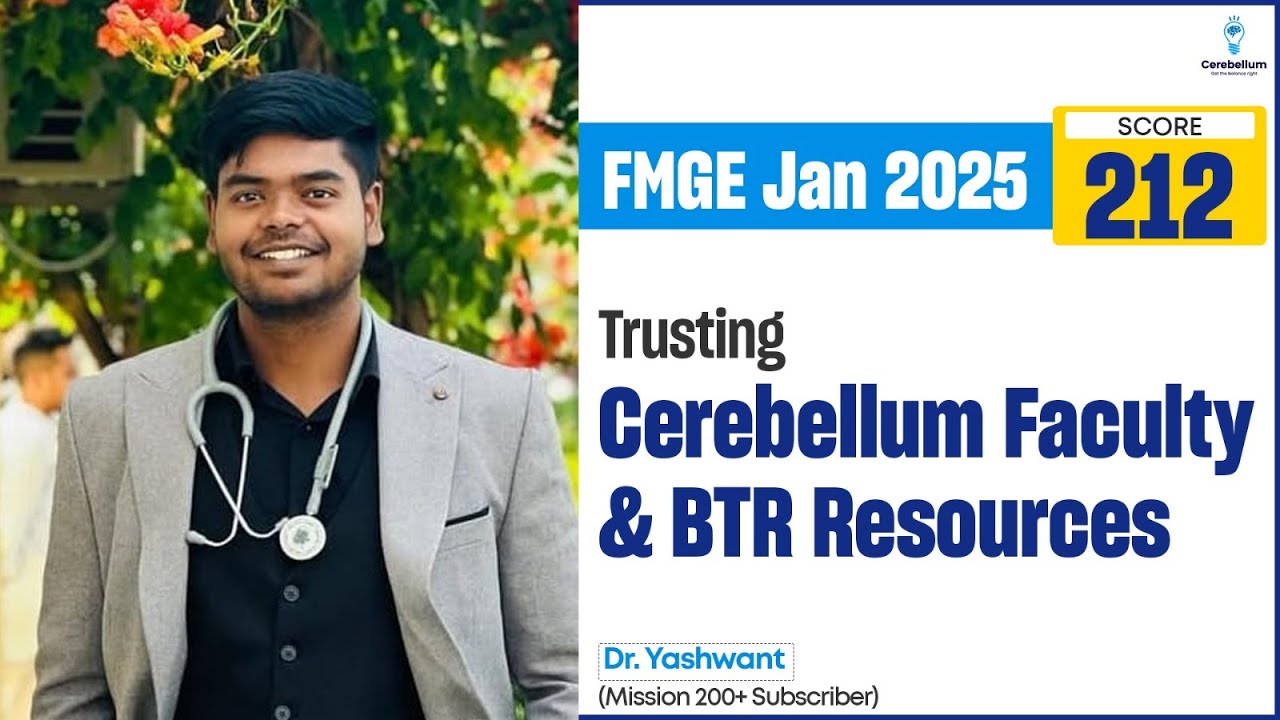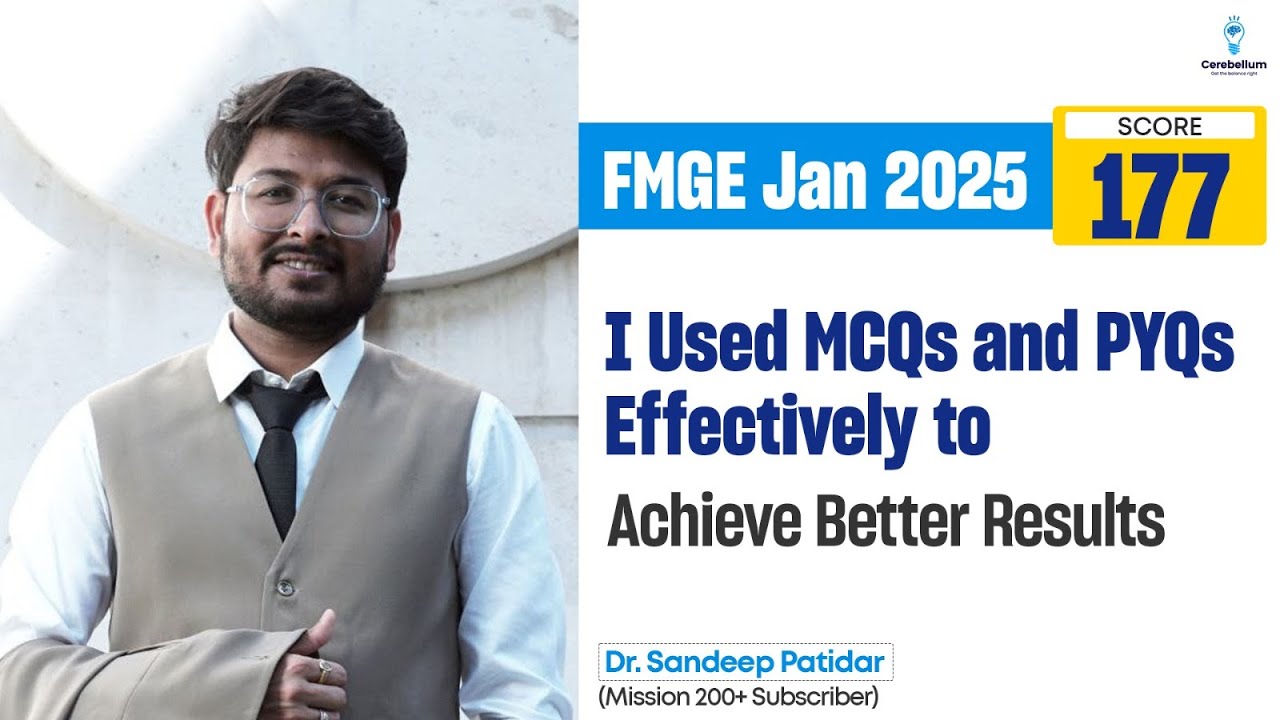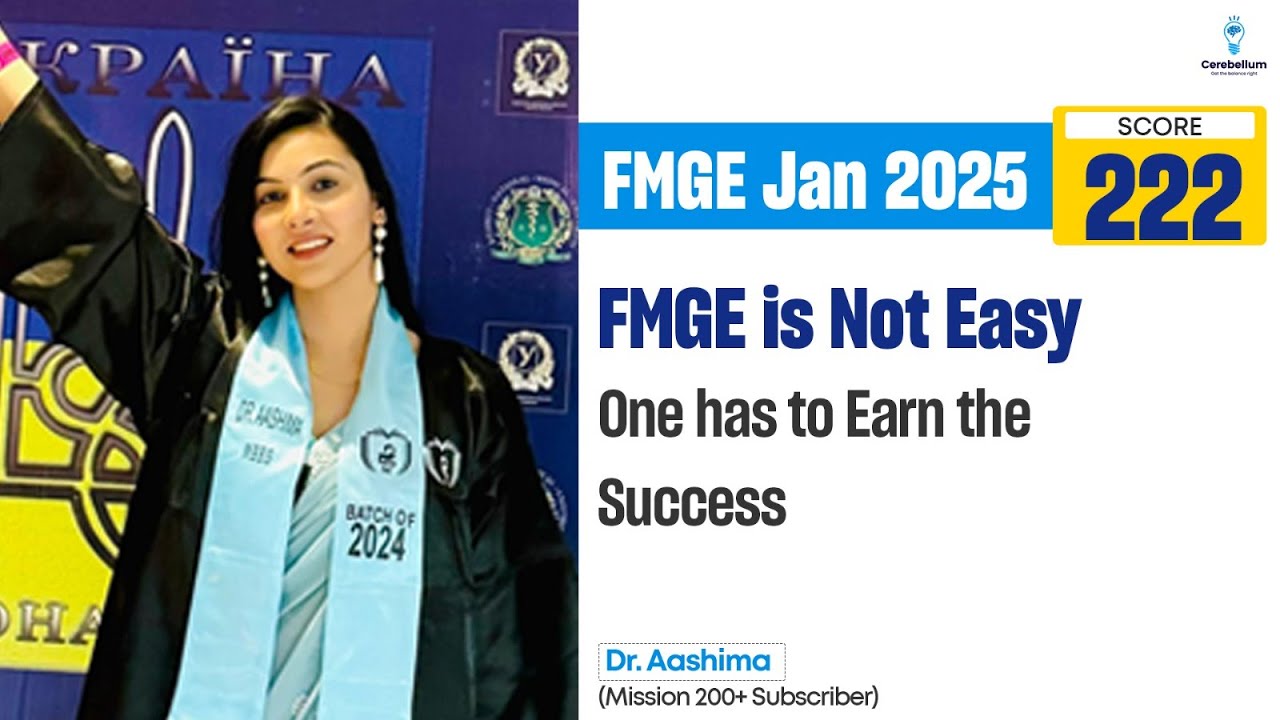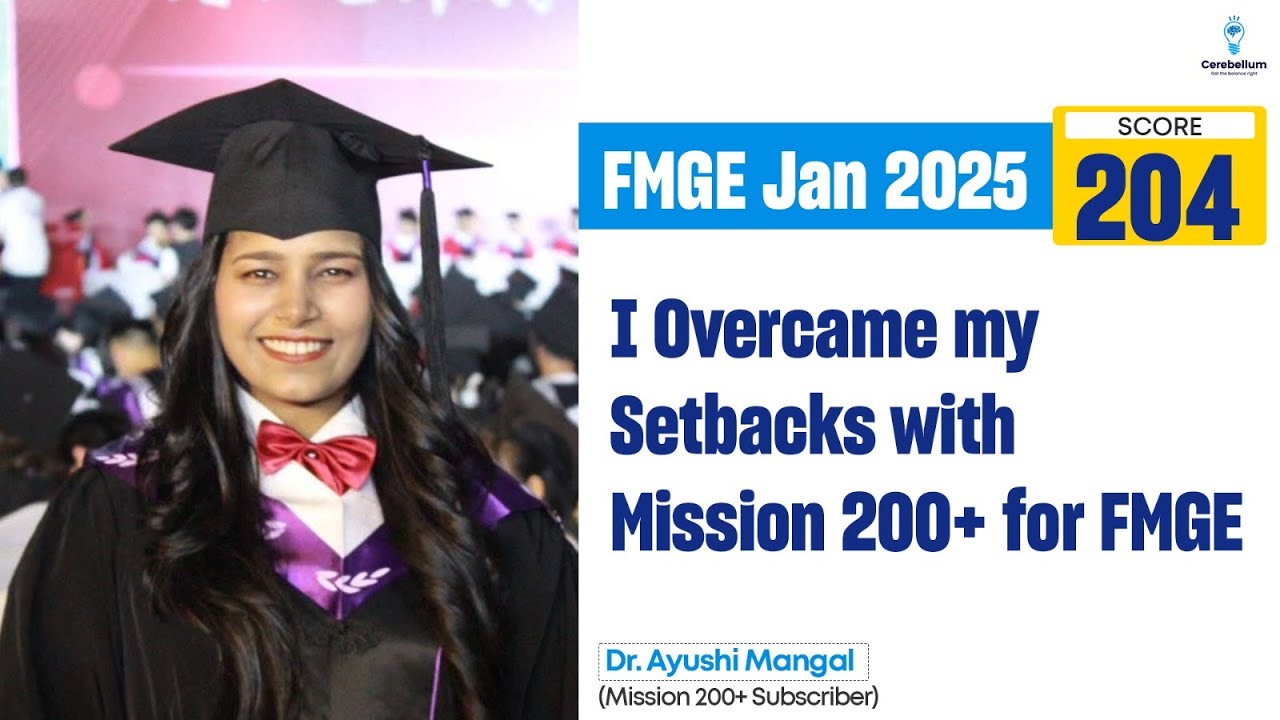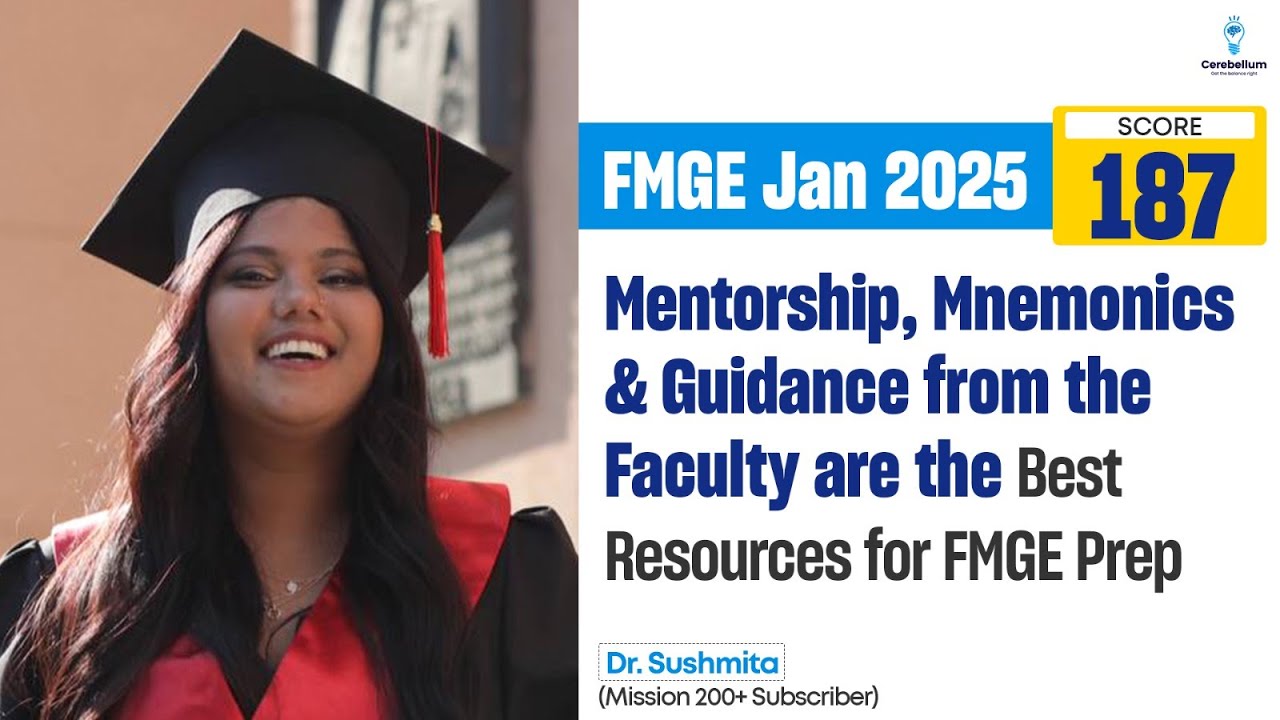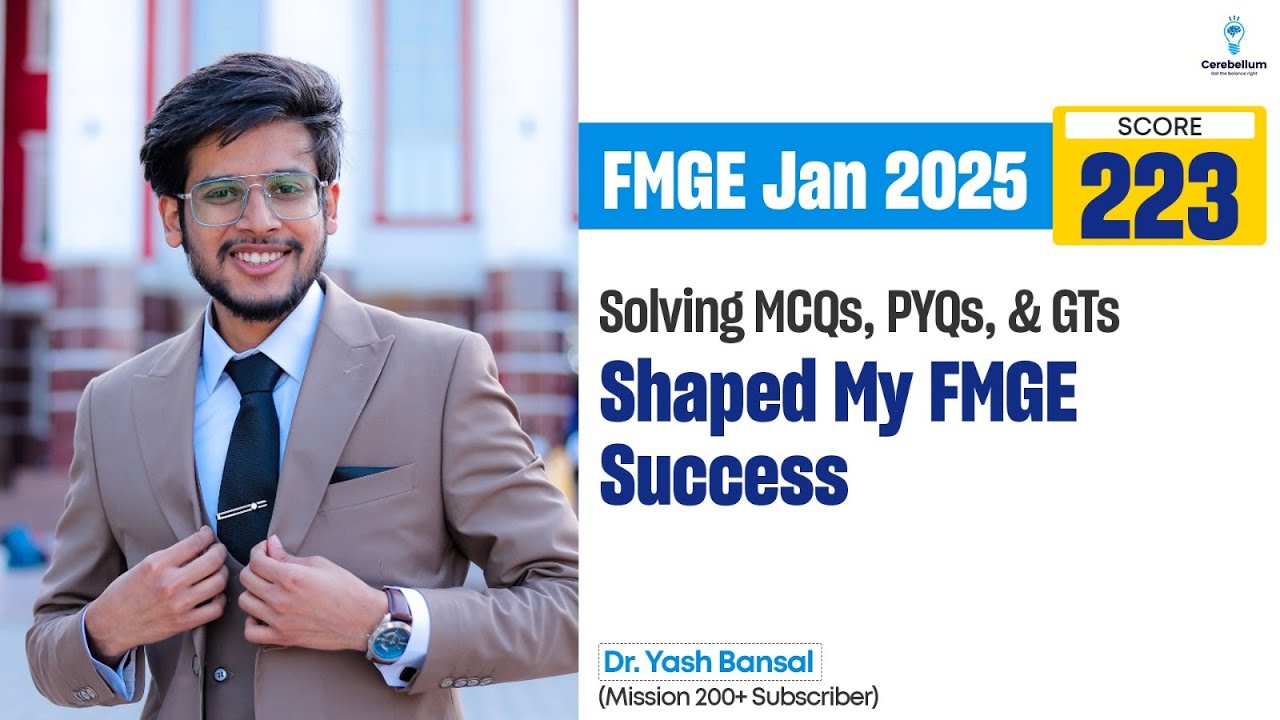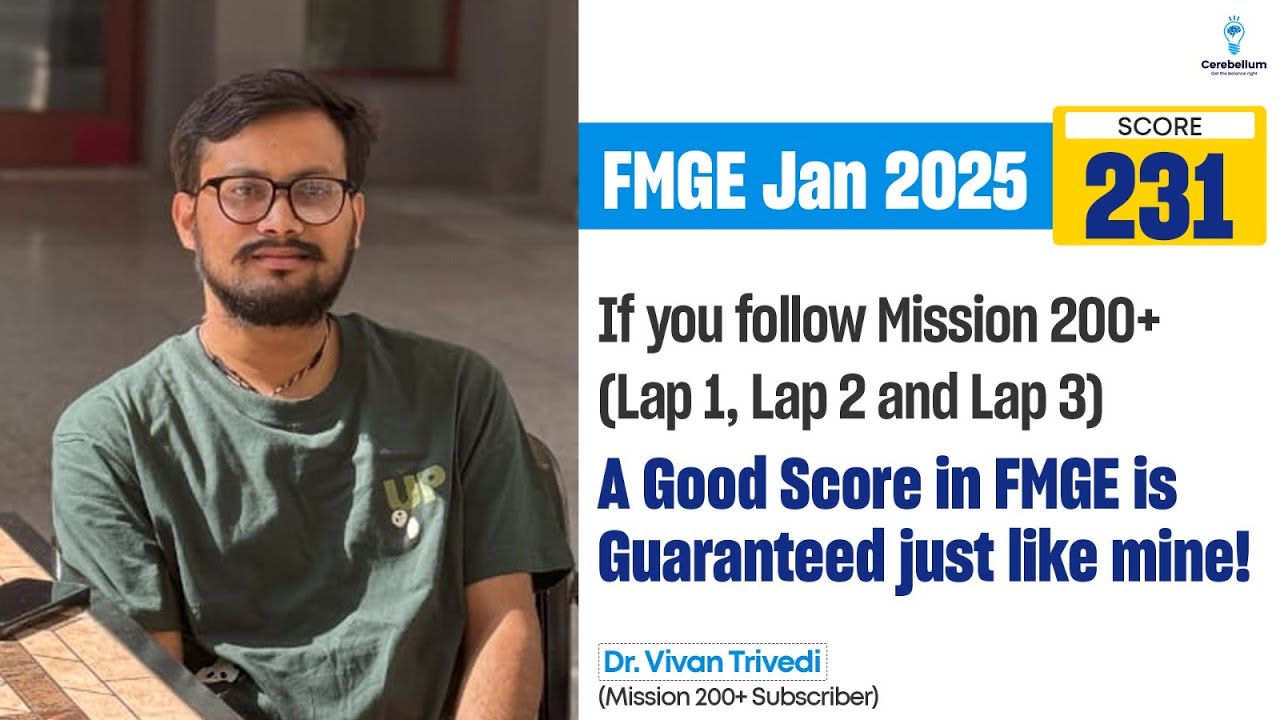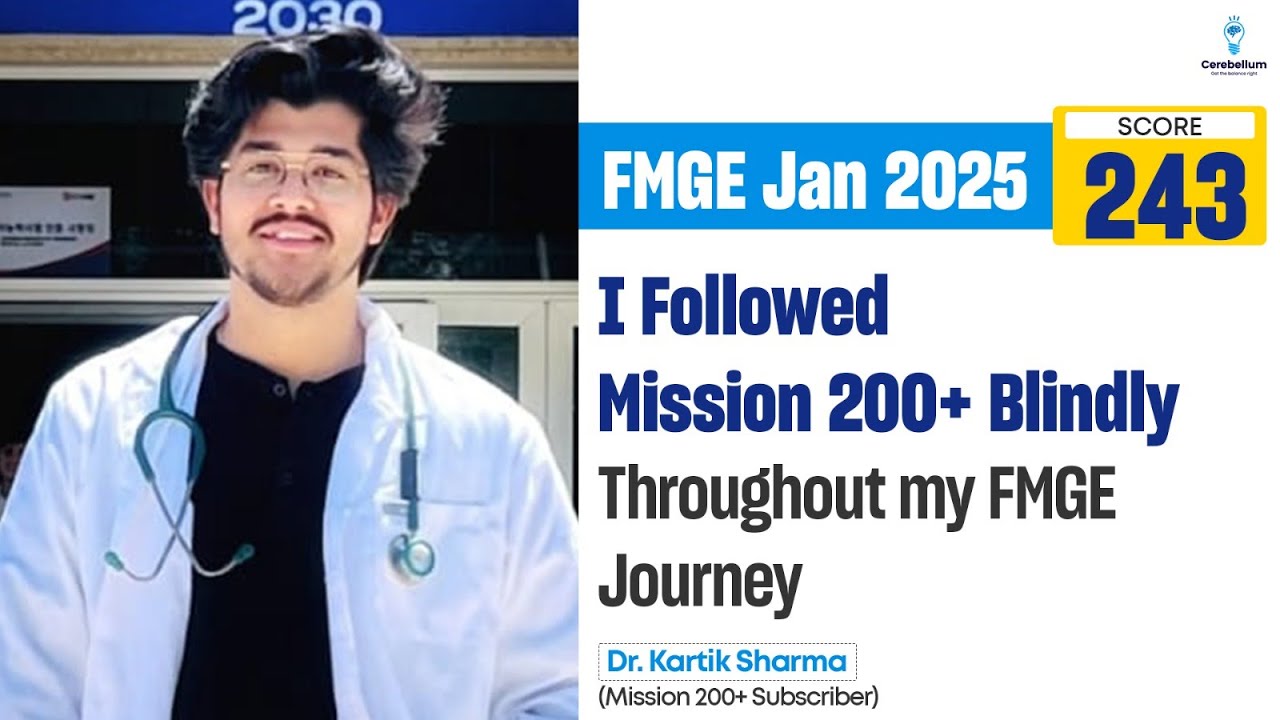Hello students, this is Dr. Praveen Tripathi and with me is the legend himself, Dr. Gobind Rai Garg.
Hello everyone. Students, today we will be discussing the schedule for NEET PG 2026 and INI CET November 2025.
We will be discussing in detail the strategy and the schedule, and how you can crack it. So, Goga sir, first of all, INI CET May was an eye-opener for us. The topper also got 80% marks.
This is quite a major difference from the last years when the students were crossing 90%. So, sir, there are certain lessons that we have learned from INI CET May 25 and also Goga sir, the second shift of NEET PG 24. Sir, do you agree with this line?
The error of the direct repeats is gone.
Yes, if not gone, they are minimal now. So, 20%, 25 of % questions were direct repeats. But now that error has gone, there will hardly be maybe 1% or 2% direct repeats.
So, questions are similar but not direct. In fact, even the PYQs that were very frequently asked, even they were asked in a twisted manner in the last 2-3 exams. Why is it important? It is important because now we know that deeper questions are being asked, and clinical questions are being asked.
Goga sir, something interesting happened. We were interviewing the top 20 students. In one of the interviews, I was asking the student, How much do you think you would have scored? By that time, he had not seen his score sheet, and he thought that I must have scored more than 85%.
And then I told him that 85% is not being scored even by the topper. So, please see that it was 75%. So, students were not even aware that they had made mistakes.
Also Read: Turn Your Midnight Scroll into a Medical Rank with Cerebellum Late Night PYQs Marathon
Why? The questions were so deep, the questions were so clinical that after the exam, students thought that they had done very well. But in reality, they had missed certain things. And this is, we are talking about: a topper, the top 20 students.
And average students, they think that we have made many more cracks as compared to what they have done. A big problem, Goga sir, that we are seeing is this word, clustering. Sir, we had almost 40,000 students taking our NEET PG mocks.
And we were looking at the result, 110 to 125, everybody is getting stuck. And the problem is that in every single mock, there are thousands of students and that too in the mocks. In the real exam, I do not know what will happen.
So, if you want to avoid clustering students, you will have to do these things you will have to develop concepts, you will have to go deeper. So, that creates a problem. The problem is that we keep on saying that revision is important.
Now, if the questions are being asked from deeper aspects of the subject, and if you have to study more comprehensively, how do I ensure at least 3 revisions or 2 revisions, that is going to be the biggest sell in Goga sir for the students who are preparing now? At the same time, students, we are very happy that Mission 2.0, the Cerebellum’s flagship program, had great results.
When we started Cerebellum, we said we would not talk about strike rate a lot.
But today we want to talk about it, we had a strike rate of 86%. 86% of the questions were from the Mission 2.0 program. Why am I talking about it? Strike rate concept, Goga sir, if I teach for 1500 hours, and if I say my strike rate is 95%, I think that is poor from a teacher’s perspective.
The good thing about Mission was that it was a program of around 400 to 450 hours.
And I am talking about the main program. This is something that is manageable in the sense that you can revise it. And because we were able to get a good strike rate with a limited duration of time, that is why we are so happy and so proud of this strike rate.
And Goga sir, all of them have seen so many talkers, so many interviewers who talked about the Mission program. So, I think we got something right here. Basically, what I used to say for 20 years, that if you are studying for 2000 hours or 2500 hours, and then you are getting 95%, 98% even 100% strike rate, that is a poor thing.
Because it is very difficult to remember so many things you are studying. But if you are doing something for 400, 450 hours, and out of that, around 90%, 85% you are getting, that means there is a high chance that you can mark that correctly in the exam. So, that is a great thing that we have got that from the limited things which we teach, not limited, that means comprehensive things, whatever is required, without any extra high-five things which are not required, and we are getting that 85% plus strike rate.
So, that is a great thing to achieve. When we started conceptualising the Mission program, Goga sir told us one thing, that the main videos can be too much. It is difficult to revise them.
The rapid revision videos are sometimes shorter. And sir wanted to create something in between, which is comprehensive at the same time, and revisable. And sir, I think your vision, we were able to hit the bullseye, something between the two, not 1000 hours, not 150 hours, 400 hours, but the strike rate speaks for itself.
Goga Sir’s structure, we keep talking about the structure. So, what exactly is the structure? So, basically, when a student starts studying, like a student who is going to prepare for 2026, they will think that I have too much time, I have one year, and I can do so much studying, so much studying. So, they start studying.
So, they will finish one subject or maybe two subjects in three months, because they try to do everything in deep. But after three months, they will suddenly realise the time is not there. Then they will try to finish everything, the rest of the subjects, very quickly.
And they will not be able to comprehensively grasp the things which they want to. So, that’s the problem because they lack the structure, because they are giving too much time for one thing and too little time for other things. So, here we are giving the program in a structured manner that you have to spend these many days on this subject, and these many days on this subject, so that you can give enough time to every subject which is required.
Goga sir, I will share something I was talking to rank 15. And he, of course, was a good student. And I asked him, Why did you come into mission classes? Why did you change the source that you were using? And he told me that he was given this advice by his senior, who follows the mission because the schedule that they give, you can just follow it blindly, and you would be able to complete everything and revise it multiple times.
So, this is what structure is all about. Completing things in time. You know, when you are studying, keep one eye on the last date as well.
Complete it in time, revise, revise, revise, go for the exam, get a great rank. So, revisions would always be the key, ensuring that revisions happen in time, while starting with the course takes you very far. Goga sir, E&D has become a very famous word.
For those who do not know it, what exactly is E&D? And you gave this word E&D. So, E&D is basically examination and discussion. So, it is a different word for test and discussion.
So, these E&Ds, these are live. So, what we commonly do we take a test, and subject teacher will give a test. So, you have to appear for that test. And after that, the teacher will discuss the questions.
So, what is the most important thing in E&Ds is, you can get to know where you are making mistakes and how you need to think about that question. Because many times, what I have seen is that when you give a test and you match the test, you can get the correct answers.
But you cannot get the crux of why that correct answer in which manner you have to think about that question. So, many times the students have benefited a lot from these E&Ds. So, they can get into the direction of how you need to think about a particular question.
So, many times in the exam, even without knowing many options, you can answer that because of your correct approach to the question. So, the art of solving MCQs is what we do in E&Ds, and then, of course, PYQs.
So, in Cerebellum, in Mission 2.0 and then the Mission 3.0 that we are about to announce, we always focus on PYQs. Why? Because when you are starting with the studies and you see the PYQs that were asked, you know which topics are important. The direct PYQs are unlikely to come.
But PYQs again are going to remain important. They were important, they are important, they will remain important. So, as we keep on saying that whatever has come, will come.
Exactly. Alright.
So, what does a student need to crack the INI CET and NEET
PG exam? So, in the last 3-3.5 years of you know running these things and the last 20 years of our experience, these are some of the things that we need to do.
Of course, complete course in time, multiple divisions, schedule and structure, I think is a big one, a big one. Knowing what to do, when to do, when to stop, when to move to the next subject, all of this is going to be very important. Again, concepts are back.
There was a time in the past when the AIIMS exam used to be conducted, and they used to ask really good conceptual questions. 75% was enough to top AIMS, there was a time. Then things changed, students started scoring 92, 94, 95 because everything was PYQ, and things are reverting to the original.
Again, concept building is important. Factual questions would always be important, but this is what is creating all the difference because this can take you only to 120, 130, the cluster. The threatening part of the entrance exam is to end in the cluster.
If you want to get away from it, concept building. MCQ practice is important, PYQ, PYT are important, and GT is important. So, all of you know that.
So, students, now we will talk about mission 3.0. So, we are in the third year, we started with mission 1.0, then we had mission 1.5, mission 2.0, and now we are ready for mission 3.0. The basic structure of mission 3.0, sir, and I will explain to you, it is a live program.
We have video-based programs, recorded videos, we have physical live programs. The mission is somewhere in between, trying to get the best of both worlds. So, say you are somebody who does not like sitting for 12 hours in a class.
There are so many students who say that, sir, in the live class after 5-6 hours, we just cannot concentrate. Then there are so many students who do not live in the big cities where all the live classes are held. At the same time, there are so many students who say that when I read, when I see a video, an hour-long video, it takes me 2 hours to complete, even when I am watching it at 2x speed.
Why? My concentration is not there. So, to solve all these things, the mission program was launched, which was a live program, and in this live program, what we need, the entire course is covered by the faculty in a live manner. You are on the app, the faculty is teaching, it is a live program, you can ask your doubts, but more than doubts, the important thing is that you are forced to follow it.
When you are sitting live and your mind starts to wander, you are afraid that you will fall behind, you will not be able to complete the course. That is what brings the discipline, that is what brings the structure, and that is what brings the success in the exam. Basically, this live program, the mission program, it will give you the benefits of both the physical class as well as the recorded videos, leaving behind the limitations of that.
Like in the physical classes, the good thing is that there is a good concentration, you follow the teacher, you are forced to study because the teacher is teaching, which you will get in the live classes. But in the physical classes, the limitation is that you need to travel long distances, and then you need to sit continuously for 10-12 hours a day. So, these limitations are not there because the live classes will be for 5-6 hours, and you can do them at your home.
So, these problems are not there. Similarly, in the recorded videos, the problem is one of concentration. You start watching a recorded video, so one thing you need to concentrate a lot, even then an hour-long video will finish in two hours, and even after that, your brain will wander here and there.
Maybe you will watch a video for half an hour, one hour, then you start scrolling the reels, a lot of time is wasted. So, that problem is not there because in this, the teacher is sitting in front of you. So, in between, you can ask doubts also, and there will be joke cracking also.
So, your concentration level is much better. So, the advantages of both of these will be present in these live programs. As you have taught and explained about E&Ds, after the live classes are over, there will be a test and discussion again live for the same subject.
Late-night PYQs. If you look at the interviews of the talkers, all of them talk about late-night PYQs. It’s a very simple thing.
At the end of the day, when you are already tired, when you don’t want to read anything new, a test is made live in the app, which has 50 questions, 70 questions in different stages, all of them are PYQs. The good thing is, once you start taking these tests for 4, 5, or 6 days, you tend to get into that habit. There were students, sir, I remember they were telling you that when they did not take the test, it felt as if something was missing.
Also Read: Complete Entire Medicine in 5 Days with This Proven Plan for NEET PG
So, that’s a beautiful thing. That is all, you know, the schedule is all about. So, I was talking to many of the talkers who got the ranks that they thinking that after the exam was over, and they were not doing PYQs at night, and they were thinking something was missing.
All right, we also have something called as midday module. Now, late-night PYQs happen late, like 10 pm at night after dinner. After lunch, when your energy levels go down a bit, some questions, 25, 30 questions, are again given in the app as a test.
In the initial part, they are from the Q bank. Later on, they are from PYQs. So, they are kind of a custom module made by the teacher.
So, basically, what happened in these midday modules, we asked all the faculties that see you have to give 200 questions from their subject, which 200 questions will you choose from the QBAN, which are the most important and those questions were chosen by the faculty and they are given as midday modules. Later as we go closer to the exam, we try to give more of PYQs. So, basically why these two things are done so that you are thorough with the PYQs because you cannot skip PYQs at least because you know that these questions have been asked.
So, similar type of questions, similar topics, they will be asked later on. And many times what the students tend to do is they keep it for last that we will do PYQs on the last month or last days and that day never comes and at the end you miss the most important thing. So, we are making you give you a habit of doing the PYQs so that why the exam comes, you have already done them twice or thrice.
Professor, we always talk about GTs. Why are they different? Kindly explain those things. So, one thing which is very important the Grand Tests, you need to obviously have practiced a lot of MCQ, you have studied a lot of theory, but finally you need to test yourself, where you are standing, where you need to work harder. So, that will come from the Grand Test.
Now, why Cerebellum Grand Tests are different from any other platform, because we do not want you to impress, we do not give the rare drugs, we do not give the rare syndromes, we do not give a very high-five question, but we will give those type of questions which are likely to be asked in the exam. Now, why we are saying that is because the recent exam which was held, INI CET exam, so most of the students who have got the marks, they have got plus minus five marks from the GTs they were giving at the last. So, they were the actual exam, simulate the actual exam, similar type of questions will be there.
Professor, you have also brought something new, Q based video explanations. So, what are these and what is the concept behind it? So, when we give Grand Tests, so most of the students, they feel very difficult to revise them or we can say analyze them. So, you have given a 200 MCQ question.
Now, when you start reading the explanations, the first reading is getting boring and the students are not able to complete them and many times they are taking two days, three days, four days also. So, then we thought of a solution that a student can see all the important things and very quickly also. So, what we did, we made the video explanation of all these questions to the point.
So, in 30 seconds or maximum 60 seconds, the question will be explained by the teacher. So, now you can quickly finish in three to four hours all the 200 MCQs which have been asked in the GTs with the help of videos. So, from videos, you can also come to know how to approach that question if your approach is wrong.
So, as I said, cue-based, the crux of the answer, the point that was being tested and important distractors in the question, everything is covered. When we started doing it, we realised that if we plan it properly, 60 seconds is more than enough to give you whatever is important in a question, and that is why, as I said, three hours is enough to review a GT, which used to be a big problem. So, lap one which will mean that live classes, comprehensive classes with test and discussion, it will continue till October last week.
After that, we will have around 10, 12, 13 days for the INI CET exam. So, there will be something called a marathon INI CET. What is marathon? Basically, as the name suggests, large number of hours, long number of hours in a day and all subjects covered.
Usually, in 70 to 80 hours, we cover the entire course before the exam. So, basically, it will be complete revision, 10 hours a day for 7 to 8 days. So, all the teachers will teach their subjects, and all 19 subjects will be completed.
So, once INI CET is done and we hope that a lot of you get selected. But after that, the second lap will start, which will continue between INI CET and NEET-PG. Again, all the tests, all the subjects, and E&Ds would be taken.
In case we get enough time, even some classes would be added. Like in this mission 2.0, all the classes were also taken in lap 2, along with the E&Ds. So, basically, it will depend upon the date of NEET-PG.
So, when that date is announced, we will see how many days we have. Accordingly, we will make that program whether to give only E&Ds or we need to add some lectures also. And still we would not be done, then we will have lap 3 of NEET-PG.
Similar to the marathon INI CET, we will have a marathon NEET-PG. Again, the idea is simple. Everything that is important should go into your brain in the last 10 days so that you are able to recall important factual questions, even conceptual questions, on the day of the exam.
So, if you follow this structure, you ensure at least 2 to 3 revisions before the exam. And revisions are what get you success in the exam. So, this is what structure is all about.
We keep on talking about structure, structure schedule. This is how it will pan out. So, again, there is a slight difference in how an intern should approach this mission 3.0 and how should then post post-intern without a job should approach the same.
So, most of the things are the same. But for interns and post-interns who have a job, we say that you can also use quick revision videos or cerebellum rapid revision videos instead of mission classes. Sometimes, if you are an intern and you are coming back home at 6 o’clock, you do not have enough time to do all the mission classes.
In that case, you can also use quick or rapid revision videos of the cerebellum. Other things remain the same. Even if you are following a quick revision video, you have to take the E&D on the day of the test. You have to do the GTs, you have to do the late-night PYQs. But this is where you can make some changes. As we say, interns have some advantage; they are fresh with the final subject.
Post interns have some advantage, they have more time. But finally, both of them have some disadvantages as well. So, you can make some changes according to your needs.
So, basically, according to your schedule of the internship, suppose you have a light posting, in that I will advise that you do mission classes. But suppose you have some hectic postings, and you have very little time to study. So, instead of doing the complete mission videos, you can go for a quick revision.
And don’t go into FOMO. In the cerebellum, so many classes are taken that even if you miss a point in a rapid revision video, that would be covered in one of the E&Ds or one of the GTs or one of the marathons. But for those who are post-interns without a job, who have a lot of time, this is the new gold standard in the preparation of NEET, PG and INI CET.
400-hour course, getting you into the top 5 of INI CET, the numbers speak for themselves. Other things you have to do, live E&Ds, custom audio, late night PYQ and GTs. This is the schedule.
So, we are starting from the 2nd of July. So, students, please look at the schedule. Paediatrics starts day 2nd July, which means on 2nd July, the live class will start.
2nd, 3rd, 4th, 5th, in around 20 to 25 hours, 4 days, classes would be completed. And then onthe 6th, there would be a test and discussion of the same thing. Similarly, after that, we have ortho, and we have physio.
So, you will see the shorter subjects have been given 2 or 3 days. Maximum subjects have been given 4 or 5 days, while yoga subjects have been given 5 days. And there are certain breaks in between for you to have a breather and catch up if something is lagging behind from your end.
The bigger subjects like surgery, as you can see, surgery 1 has 4 plus 1 and surgery 2 has 4 plus 1, around 8 days for surgery. For medicine, I think you have 10 days. This is the tentative schedule.
Some subjects may go up and down, but in a broad manner, do this. All right. So, on 27th of October, we will complete the lab 1, which is the more elaborate lab.
And after that, we will start with the marathon INI CET. Goga sir, anything on that? No. Most of that have been covered.
So, how to use Mission 3.0?
If you are a new student in Cerebellum, how to use it? You should watch live classes or videos. So, on the 2nd, you start with paediatrics. In the evening, you saw the class, made some notes.
We would recommend that you use the printed notes and make additions to them. In the morning of 3rd, if you are a post-intern without a job, revise it. In the afternoon, do a custom module or our midday module.
And in the evening, the 2nd day would start. Similarly, 1st day, 2nd day, 3rd day, and 4th day, continue to revise it. And then on the 5th day, you have your test and discussion.
Appear for the test, attend the discussion, and that subject is over. Go to the next subject. In between, you will keep on having GTs so that your memory keeps on getting refreshed.
Goga sir, one question. This GT thing, how long should the student wait before starting with the GTs? So, we will say that do not wait at all. So, when to give GTs? Today.
So, that is the right day. So, whenever we conduct the GTs, you have to appear whether you have completed one subject or 10 subjects. It does not matter at all.
So, the important thing is whatever subjects you have already completed. So, make sure that you are not making mistakes in them. If you have not completed a subject, you are making a mistake.
It does not matter. But keep on giving the GTs because that will give you a habit of attempting the paper, how to finish the paper in 3 hours. And many things that you actually are making mistakes in the exam will not happen if you have given a lot of GTs.
Correct. So, continue with the course completion along with the schedule.
So, Mission 3.0 is not only about live classes.
First of all, in case you miss a live class, you can watch it. It would be recorded. It would be uploaded in the app along with the PDF.
You can watch it the next day also. But Goga sir keeps on saying this thing, try not to miss a live class because the discipline that comes with the live class is something different. But say there is a subject in which you are very weak, and you want to improve your knowledge.
So, you also get recorded main videos, the bigger videos, and 1000 hours of content. And the Cerebellum provides you both English as well as Hinglish videos, except for medicine. We are teaching the lecture in Hindi.
Otherwise, 18 other teachers are speaking in Hindi as well. And you also have rapid revision videos or quick revision videos. You have complete access to it.
Qbank, you get complete access. Although we say to use Qbank in a smart manner in the last year of preparation. If you are in your second year, third year, final year, Qbank is great.
But if you are preparing, if you are an intern or if you are a post-intern, more of custom module, more of a late-night PYQ, more of a midday module than Qbank. GT is a part of it. Late night PYQ medicine is a part of it.
And BTR by Dr. Zainab is also a part of this program. Notes.
Now, this is a big question, which notes to use? Goga sir.
So, basically there are three types of notes in Cerebellum.
One are the mission notes, which are called as workbooks. Second, we have main notes, which are of main videos.
And third are the quick revision notes or which are for rapid revision videos. So, what we recommend is to go for the quick revision notes. They are almost aligned with the mission classes.
And you can also use workbooks if you have a habit of writing something. Because there will be around 10 to 20% vacant spaces in the mission workbook to give you an active record. So, you can, if you have a habit of writing, then go for mission workbook.
Otherwise, we will advise going for a quick revision. Even in quick revision notes, you will have to write, and it is good. See, when you when you write a bit, it goes into your memory, it is retained better by your brain.
So, in both the cases, you will have to write something which is a good thing. It has been designed in that way to improve your record. Timings of the classes, sir? So, time classes will be evening at 5.30 pm.
Daily the classes will be conducted from 5.30 pm and they will run till maybe 9.30, 10, 10.30 depending upon the teacher.
So, what if you miss a class?
So, first thing, do not miss a class. Try not to miss as far as possible.
But inadvertently, if you miss a class, you will get a recorded video the next day.
What if you have used another source?
I am telling you one thing, Goga sir used to give a different answer for this question. But after NEETP 24 and INI CET 25, he is giving a different answer.
So, I used to say that whichever source you have studied earlier, keep sticking to that only and just give E & Ds and other things from here. But now my mind has totally changed. Now, I will say that whatever source you have used earlier, now do it from Cerebellum only.
Because we have seen the discipline which is being forced by Cerebellum plus the amazing teachers you will get here. You will forget every other source. There were students who told us that sir, whatever live classes we attended, we were able to complete it and revise it.
And when we tried using some other resource, we were never able to complete it. So, see, we always say teachers are good, but the structure that is here, that you know is the cherry on the top of the cake. So, that is why I follow the program end to end and now the results speak for themselves, I mean, strike rate of 86 percent with limited duration of content.
So, the results are great.
So, if you have yet not joined Cerebellum, you can go on to the website www.cerebellumacademy.com. In the plans, you will be able to see mission 3.0 batch 1. So, join it and on July 2nd, we are going to start with this very successful program, and we just hope that you follow it the way it has been scheduled, and we can promise you that if you give your best, the results will be amazing. So, see you in the live classes, just follow the schedule, you do not need to apply your brain because we have already applied a lot of brain in making this schedule.
And mind you, this is not for one person, this is 20 20-year experience of around 16-17 teachers, who have made this schedule. So, you do not need to worry about anything, just follow the schedule and success is guaranteed. So, all the best.
Download Cerebellum NEET PG Preparation Android app
Download Cerebellum NEET PG Preparation iOS app
Download Cerebellum NEET PG Preparation iphone app

